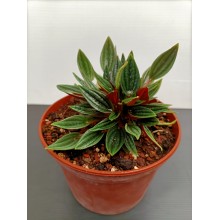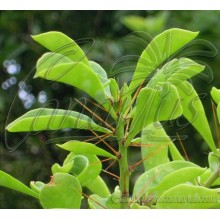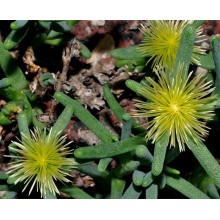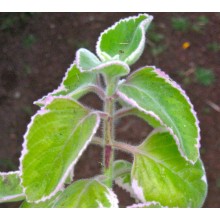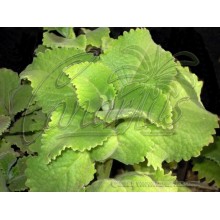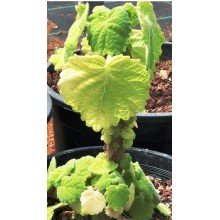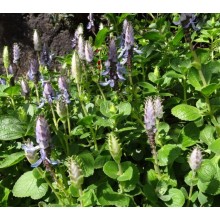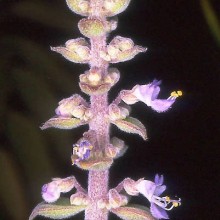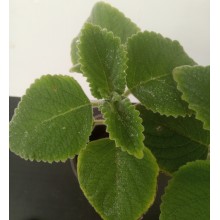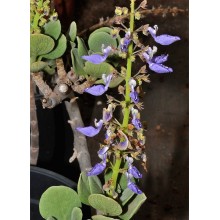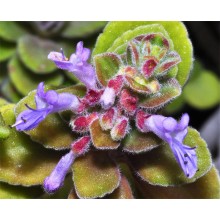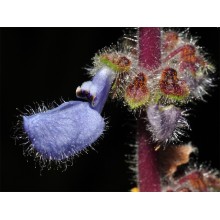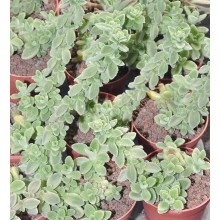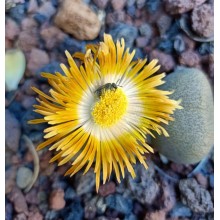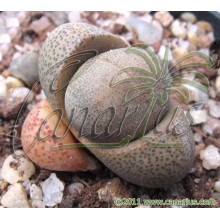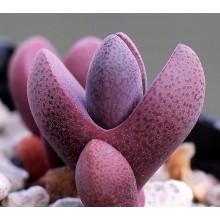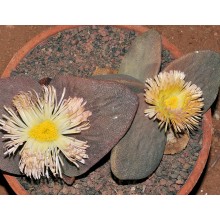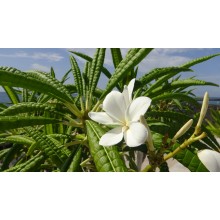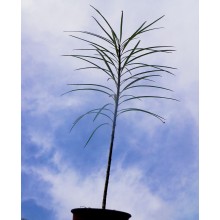Succulents There are 628 products.

World deserts and dry areas are home to the most interesting plants. Canarius offers an increasing selection of succulent plants of maximum quality, because they are grown outdoors, under the full sun of the Canary Islands.
Succulents or "fat plants" are water-retaining species, adapted to dry conditions. They store succum (juice, water) in their leaves, stems or roots, and often show a stout and fleshy appearance.
Subcategories
-
Agave
Agave is a genus of succulent plants from America. Some species grow in cold areas and take hard frost, while some others live in tropical climates. Some are tiny dwarfs and some are giants, up to 2 or 3 m wide.
Cold hardy agaves can create an exotic effect in your garden. Agave species make fine companions to palms or cacti. Variegated agaves are incredibly sought after by collectors. Our web shop offers an ever changing selection of species. We ship bare rooted plants, unless otherwise specified.
-
Aloe, Gasteria & Haworthia
Aloe, Gasteria and Haworthia are three related genera, comprising hundreds of succulent plants. They are all easily grown in pots. A few adapt to low-light levels of indoor conditions and can be grown as house plants.
- Aloe is a genus of about 400 species, native to Africa, Arabia and Madagascar. Small or dwarf aloes are becoming especially popular in colder climates as they can be taken indoors during the hardest months.
- Gasteria includes some 80 species endemic to South Africa, known for their spectacular leaves which are glossy, mottled and textured. They bloom in Spring-Summer with long spikes of small orange flowers. Some species are so variable that we offer particular clones from specific locations.
- Haworthia is a genus endemic to South Africa with about 70 species and a number of local subspecies, varieties and forms. Leaves are often banded, speckled, dotted, or semi-translucent and show wide variations.
-
Crassulaceae
This is a new, growing section of species from the family Crassulaceae. There are about 1,400 species in 33 genera and their distribution is worldwide, but mostly occur in the Northern Hemisphere and Southern Africa, especially in dry habitats. Here you can buy healthy, sun-hardened plants grown in the Canary Islands and shipped to your home.
-
Mesembs
This group of desert plants is briefly named Mesembs because they belong to a botanical family formerly named Mesembryanthemaceae. There are almost 2.000 species, mainly found in Southern Africa, with extreme adaptations to dry habitats. Some are called "living stones", as they look like pebbles. Many are easy to grow and their main need is full sun. Some are difficult because they grow in truly extreme areas.
Our Web Shop offers sun grown healthy plants, with compact and colourful leaves. Some plants are sold as cuttings, and others as rooted plants, of at least two years old.
-
Sansevieria
Recently assigned to the family Asparagaceae, the genus Sansevieria counts about 70 species, nearly all native to Africa, Arabia and Madagascar. Perennial herbs adapted to dry habitats with stiff, succulent leaves, their length ranges from a few centimeters to 2 meters. Sansevieria trifasciata and its many cultivars are among the most popular houseplants, popularly called mother in law's tongue. A well grown plant usually produces a spike of many white, richly scented flowers and then orange berries. Even the rarest species are resistant to neglect, provided you keep them from frost in winter and scorching sun in summer.
-
Hoya
Hoyas are twining vines, with showy exotic flowers, from the rainforests in Asia and Oceania. Most species grow in bright shade or morning sun, but they will also grow indoors as house plants. They are well suited for baskets, trellises or ladders. They tolerate a few weeks of drought but they are sensitive to frost and cold. Many hoyas are easy to grow and bloom, while some are tricky and rare.
-
Asclepiads
Asclepiads or Asclepiadoideae are a subfamily in the Apocynaceae, with about 2900 species. There are lots of leafless stem succulents but also perennial herbs, shrubs, lianas or rarely trees. They produce remarkable flowers, for the complex mechanisms they have developed for pollination. Many species produce an unusual fragrance, often called "carrion", and attracts flies for pollination. -
Caudiciforms
These plants from dry areas produce an unusually thick stem, the caudex. They are also called pachycauls and they have a disproportionately thick trunk, often with few branches. The caudex can be hidden underground, but in most cases they grow upwards, forming spectacular trees. The largest caudiciforms in the world are the baobabs. -
Other succulents
Here you will find all those species of desert plants that are not included in their own category. We will place here all plants from unusual families, other than Agaves, Aloes, Crassulaceae, Sansevieria, Mesembs, Epiphytic cacti, etc.
-
Peperomia x 'Eden Rosso'
Peperomia x 'Eden Rosso'
Very elegant and compact Peperomia hybrid, developed in Holland around 2010 through a well-thought selection program. It is a cross of Peperomia marmorata × metallica.
16,30 € -
Pereskia zinniiflora
Pereskia zinniiflora
NEW ! - Pereskias are leafy and spiny trees in the Cactus family. This species has small leaves and nice pink rose-like flowers. This is the Cuban form. It grows a thick root and it can be easily grown in pots and kept as a shrub or even bonsai.
32,00 € -
Phyllobolus prasinus
Phyllobolus prasinus
Small shrubby mesemb, with "bonsai habit" and showy yellow-green flowers. It grows a perennial short branched stem and each year it will build the new shoots with leaves and flowers, which are weakly lignified and will last only one season.
22,00 € -
Phyllobolus tenuiflorus
Phyllobolus tenuiflorus
This winter growing mesemb from South Africa builds a short and wide caudex year by year. From this perennial trunk, each year it will grow the new shoots with leaves and showy flowers, which are weakly lignified and will last only one season. It also has a showy epidermis, with showy bladder cells full of water.
32,00 € -
Plectranthus amboinicus 'variegatus'
Plectranthus amboinicus 'variegatus'
This is a beautiful variegated selection of a popular aromatic plant, used much like oreganon. It grows as a creeping shrublet, up to 30-50 cm tall. The blue flowers are also a nice addition to a beautiful species.
10,50 € -
Plectranthus amboinicus - Tropical Oreganon
Plectranthus amboinicus - Tropical Oreganon
This edible plant is grown and used much like oreganon. Beautiful thick, hairy leaves and flowers. It is easy to grow in pots and very ornamental. It is a perennial, semi-succulent herb.
16,80 € -
Plectranthus burorum
Plectranthus burorum
8-12 cm rooted cutting. Rare Plectranthus from Somalia, described in 1929. It has a thick succulent stem and rounded, velvety leaves. The blue flowers are held on unusually long petioles.
27,50 € -
Plectranthus caninus
Plectranthus caninus
Shrubby succulent with ornamental foliage and elegant spikes of showy blue/purple flowers. All leaves and stems are velvety very aromatic, rich in volatile oils. It is native to dry-deciduous forests in E Africa to India. Grows perfectly in pots or garden rockeries. Better protected from frost.
10,50 € -
Plectranthus cylindraceus Jabal Hadaba
Plectranthus cylindraceus Jabal Hadaba
8-12 cm rooted, branched cutting. This pant was collected in the Al Marha province of Yemen. It was originally identified as P.cyindraceus but it is different from the forms found elsewhere.
16,40 € -
Plectranthus foetidus 'Mt. Carbine'
Plectranthus foetidus 'Mt. Carbine'
This edible plant is grown and used much like oreganon. Beautiful thick, hairy leaves and flowers. It is easy to grow in pots and very ornamental. It is a perennial, semi-succulent herb.
14,80 € -
Plectranthus hyemalis
Plectranthus hyemalis
Mildly scented shrub to about 1 m tall, with attractive, rounded leaves, and beautiful blue-violet flowers. Plectranthus hyemalis was described in 1984, and it is native to rocky slopes in Southern Yemen, at about 1000 m asl.
26,80 € -
Plectranthus socotranus
Plectranthus socotranus
8-12 cm rooted cutting. All plants from the island of Socotra are somehow special and attractive. This Plectranthus is very small and compact. It bears fleshy leaves, just 1-2 cm long, green with a silvery bloom on the upper surface, sculptured with raised veins on the convex lower surface. It bears beautiful purple-blue spikes of flowers.
22,50 € -
Plectranthus sp. Galgallo
Plectranthus sp. Galgallo
8-12 cm rooted cutting, This is the "Mystery Plectranthus" collected in Galgallo, Somalia. It is very attrative because of its compact and symmetrical growth and flowers are simply spectacular, with abundant "hairs".
15,30 € -
Plectranthus sp. Ngorongoro Crater
Plectranthus sp. Ngorongoro Crater
Rooted cutting, with one ore more new growths.
14,00 € 16,00 € -
Pleiospilos bolusii
Pleiospilos bolusii
NEW! - Cont.= 8,5 cm - Popular species of living-stone from South Africa, with thick succulent leaves imitating rocks. It takes light frosts.
10,70 € -
Pleiospilos nelii
Pleiospilos nelii
Cont.= 8 cm. Nearly spherical living-stone succulent plant, with pale mottled green leaves. It is hardy to frosts of about -3 C if kept dry.
10,90 € -
Pleiospilos nelii 'Royal Flush'
Pleiospilos nelii 'Royal Flush'
Japanese selection of a red-purple form of the popular "living stone", with pink flowers instead of yellow.
18,70 € -
Pleiospilos simulans
Pleiospilos simulans
This living-stone plant is a living myth, as it was considered extinct until about 2014, when it was rediscovered in the wild in S of Klipplaat, Eastern Cape, South Africa.
21,80 € -
Plumeria filifolia
Plumeria filifolia
Beautiful non-hybrid plumeria with thin, glossy thread-like leaves, dark green above and yellowish below. It blooms abundantly in during the growing season. Grafted plant!
142,00 €
At the moment there are few products in this category Succulents

























